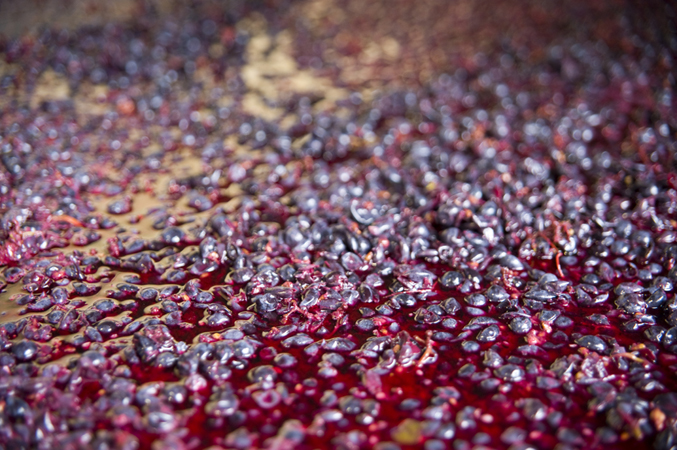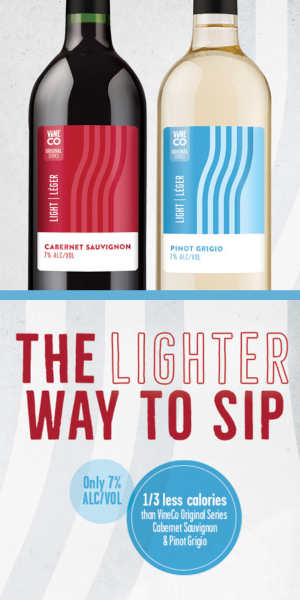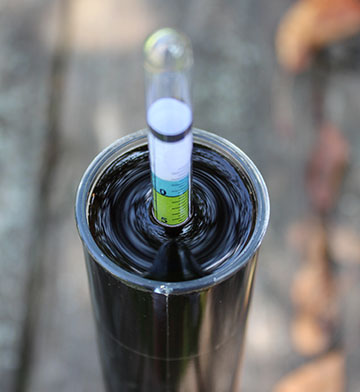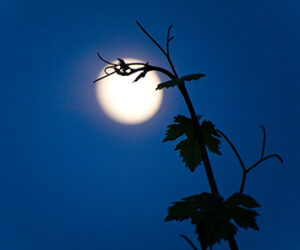 From modern wine chemistry labs to your home winery — what is known about tannins and how can winemakers control their impact on their wine? Research is debunking many widely-held beliefs about tannins, but there are still proven ways to get the structure you desire without excessive bitterness or astringency.
From modern wine chemistry labs to your home winery — what is known about tannins and how can winemakers control their impact on their wine? Research is debunking many widely-held beliefs about tannins, but there are still proven ways to get the structure you desire without excessive bitterness or astringency.
Here’s a quick summary of the conventional tannin wisdom of a few years ago, still in wide circulation among both commercial and home winemakers:
• Grape skin tannins are your friends, seed tannins are your enemies.
• After fermentation, as wines age, tannins form themselves into longer and longer chains.
• Those longer chains are softer and less astringent in the mouth.
• Eventually, with really mature wines, the chains get so long that they precipitate out of the wine entirely.
Alas, every one of these assertions is at best wildly over-simplified, if not dead wrong. Research in the past decade has undermined most of the traditional tannin myths, opening a window on a vastly more complex world of phenolic interactions than previously thought. Instead of these simple “truths,” phenolic scientists have long lists of questions about things they don’t yet understand.
There is no reason, however, for the rank-and-file home winemaker to throw up his or her hands and just let the tannins fall where they may. There are plenty of things that are known, that are verifiable, and that do lend themselves to vigilant management in your home winery. Because of their contribution to wine structure, mouthfeel, color stability and ageability, tannins are way too important to ignore. But first, it helps to clear out the conceptual underbrush.
Seeds and Skins
Grape seed tannin has a miserable reputation among many winemakers. It’s something to be avoided, like moldy clusters or dead lizards in the crusher. Seed tannins are alleged to be harsher, meaner, greener, more astringent and downright unpleasant, especially when compared to the better-behaved skin tannin cousins. Seed tannin avoidance is often the motivation for various methods of seed removal, early pressing and staying clear of extended maceration. All this worrying may focus on the wrong problem, since it’s unlikely that seed tannin is the culprit in most overly tannic wines.
Grape tannins, skin or seed, are combinations of compounds collectively called flavanols. These compounds — catechin, epicatechin, epigallocatechin — can exist by themselves (monomers), but dearly love to link up in multi-unit chains (polymers). In fact, to qualify as a tannin, at least two units have to be entwined. Besides craving each other’s company, tannins and their building blocks can’t wait to bind with all manner of other compounds, making their family tree pretty complex.
In the grape, seed tannins are far more plentiful, weighing in at 3.5 to 5 milligrams per berry, compared to 0.5 to 0.9 milligrams worth of skin tannin. But the individual seed tannin polymers are smaller/shorter than the skin tannins; research by Jim Harbertson of Washington State University suggests that seed tannins average around 10 units compared to over 30 units for skin tannins. And once again, size matters.
Astringency in the mouth is caused when tannin binds with the protein in saliva, leaving tissue scratching tissue without its usual lubrication. And despite the common belief that longer is better, studies in France a decade ago demonstrated that longer tannin chains are more astringent and shorter chains less so. Think about it a minute, and the long chain versus short chain difference makes sense. Imagine filling your mouth with smooth beach sand, and then filling it with crunchy pea gravel. Which would hurt worse?
(For those who are fond of finding “minerality” in wine, you could try this at home; for the rest of us, this is just a thought experiment.)
At this point, the seeds are starting to look like our friends. The shorter length of seed tannin chains has a down side, however: bitterness. Low molecular-weight tannins (short ones) taste bitter, while longer ones have texture (astringency) but no taste. Phenolics researcher Jim Kennedy at Cal State Fresno suggests the reason is that the bitterness receptors in our taste buds are simply too small to taste the big boys; they get a pass, while the shorter chains come off as bitter.
So, at harvest time, the story is that skin tannins could end up giving us too much astringency, and seed tannins could give up bitterness. But our wine needs them both for mouthfeel and color retention. And then, the minute the grapes hit the cellar, all bets are off; the logic changes entirely.
Grape vs. Wine Tannin
In the fermenter, skin tannins, which are less plentiful, come out earlier and more easily; most are water-soluble and don’t need either heat or ethanol to coax them out. Seed tannin, on the other hand, is far more stubborn, coming out only with ethanol as a solvent and even then at a much slower pace. Skin tannin extraction plateaus after a while; seed tannins come out slowly but steadily and for a much longer time, including during any extended maceration on the seeds and skins.
And then, all hell breaks loose. Once these building blocks get into solution in something resembling wine, they immediately begin forming and reforming, reacting with everything in sight, producing what UC Davis wine chemist Doug Adams calls a “chemical train wreck” and Australian Wine Research Institute (AWRI) researcher Paul Smith calls “a freaking nightmare.”
Tannin chains link up with each other, then break apart. Oxidative reactions change the structure of some, and acid-catalyzed reactions transform others. Maybe the best thing (some) tannins do is bind with anthocyanins, the basic color compounds, forming polymeric pigments that ensure long-term color stability — one reason why getting rid of all the tannins would be a bad idea indeed. Others morph into forms that provide structure and mouthfeel to wine, without getting mean in the process.
By the end, says the AWRI’s Smith, only about 20% of the tannins in wine have the same structure as the tannins that came from grapes. The other 80% represent tannins that have followed numerous different trajectories, the mix varying with the surrounding chemistry of each batch of wine. Researchers aren’t entirely clear on what half of these compounds do for a wine.
One thing that tannins do not do, however, is uniformly combine into longer and longer chains. And a good thing, too, since as discussed earlier, that would make for a much more astringent wine. Fortunately, many of the tannins decide to do something else.
Where Do Tannins Go?
Back to the former conventional wisdom. In that model, tannins get longer and longer (wrong) and thus smoother and smoother (wrong) and eventually so big that they precipitate out of solution and end up in the sludge at the bottom of the bottle. This is one possible tannin fate; chains that bind up with proteins as well as other tannins can finally become too big to remain soluble and fall out. But not that many of them.
Another study at the AWRI analyzed tannin levels on a 50-year vertical sample of Australian Cabernets from a single producer. Turns out that while there was, naturally, a lot of vintage variation, there was no overall sign of a tannin drop-off; some of the oldest vintages contained higher phenolic levels than some recent vintages. Whatever else the tannins did, they didn’t just disappear.
Sometimes, tannins don’t go anywhere at all; some wines are born hard and stay that way indefinitely. But more often, the perceived level of tannin (even if not the sheer quantity of tannin) drops with time, and assuming some fruit is still around, the balance in a well-aged red shifts in a harmonious way. Why that happens researchers flatly do not know; they just know that 1) the tannins don’t all get longer, and 2) they don’t just go away. The rest is the research frontier. Perhaps this is why Paul Smith says, “One thing that is good about being a tannin scientist is you know you’ve got a job for life — if the funding keeps coming in!”
Out of the Lab, Into the Garage
So while we’re waiting for scientists to figure this all out, can a home winemaker do anything to improve tannin management? Sure.
Your garage or basement of friend’s spare bedroom probably does not come equipped with sophisticated lab equipment that could spit out useful numbers about total phenols and the various flavors of tannins in your grapes and your wine. What you have are your taste buds and a list of things to consider.
Grape Varieties
Some grape varieties carry a bigger tannin load than others, including the fact that smaller berries (with a higher skin-to-pulp ratio) are likely to deliver more tannin per pound of grapes than larger berries. Cabernet Sauvignon, Tempran-illo, and Nebbiolo are all high on the potential tannin index; Merlot, Zinfandel and Syrah are somewhere in the middle; Grenache, Cinsault and Gamay are at the low end. Hybrid red varieties are well known for their lack of tannin, so the issue at hand will be providing some structure, not avoiding tannin excess.
Vineyard Climate and Location
Where the grapes come from also matters. Cooler growing regions are likely to yield grapes that are somewhat less ripe, and so the generally higher acidity will make the tannin level more noticeable — they don’t necessarily contain more tannin, they’ll just yield wine with the perception of more tannin. Riper grapes — or overripe, as in the current fashion — bring higher alcohol and higher levels of polysaccharides, both of which mask the potential bitterness and astringency of elevated tannin. Grapes from very warm climates, like California’s Central Valley, develop plenty of tannin, but develop thicker, tougher skins (as a weather defense) that make tannin and color harder to extract.
Seeds
And it’s worth counting seeds. Different batches of the same grape from the same growing region can differ in the number of seeds per berry, and the difference between one seed per berry and three is not trivial for tannin extraction. Somewhere between one and two is the norm; if your grapes seem very seedy or hardly seedy at all, take note.
Wine Style
Decide wine style early on. Your grapes naturally set limits on what you can and can’t do in terms of wine style. No cellar magic will turn your New Hampshire Chambourcin into a Napa Cab. But within the range of the possible, it’s important to decide up front where you want your grapes to be headed — a big, highly-extracted, structured, possibly ageworthy style, or a lighter, easier-drinking, picnic wine, or something else entirely. Any wine style you happen to enjoy drinking is a valid objective, and the sooner you start your grapes down that track, the more likely you are to get there.
At the Crusher
Wine style starts at the crusher. The gentler the crush, the more whole or barely-bruised berries come through, and the slower the tannin extraction will be. For lighter-style wines, a gentle crush is ideal, avoiding shredded skins and crunched seeds. The crush is less important for bigger styles, since there are several more points at which extract can be boosted.
Enzymes and Yeast
Fermentation variables are the main factors in controlling tannins. If you are aiming big, or have what you know are tannin-deficient grapes, you may want to use some form of extractive enzyme. Whatever they do for color, ColorPro and other color-booster enzymes also add to tannin extraction.
There are also yeast strains that may do more for enhancing structure and mouthfeel, and others that emphasize varietal character and bright fruit.
Temperature
Fermentation temperature can make a big difference: higher temperatures, up around 90 °F (32 °C), will pull out more of everything, while a cooler climate, down nearer 80 °F (27 °C), will pull out fewer tannins and preserve more fruity flavors and aromatic esters. Punchdowns, usually twice a day during fermentation, can be increased or decreased and made more or less aggressive, depending on your style goals.
Handling the Cap
Many winemakers use a technique called délestage in France, or rack and return in Australia, or drain and fill in older textbooks. The floating cap of skins and seeds is separated, one way or another, from the fermenting liquid; both parts get exposed to air for a few hours; and then the elements are reunited. Besides giving an invigorating blast of oxygen, delestage allows for removing a portion of the seeds, which is a motivation for some winemakers.
Chances are that removing only a small portion of the seeds won’t make much difference; and research shows that removing all of them can be a mistake, knocking the mid-palate out of the seedless wines. Delestage might be a good idea for other reasons, but it can also contribute in a small way to tannin control.
Sample As You Go
From the time the fruit arrives and all the way through fermentation, make sure to taste, taste, taste. The brew of part juice, part wine, and a part yeast cells isn’t an elegant beverage, and you may want to floss afterwards, but you can tell a great deal about where a wine is headed by tasting it in its infancy. In particular, tasting is the best way to spot a buildup of excess tannins — a noticeable astringency poking its way through the fruit and muck. Your assessment of the progress in extracting tannins can influence decisions about pressing.
Pressing
The timing of pressing is an important decision in tannin management. Waiting until the wine is fully dry gives more time for extracting tannin; all the color and flavor elements you are going to get are already in the soup. Pressing a bit early, when the Brix is still at 2 to 4 °Brix, cuts down on tannin extraction. Letting the wine stay on the skins and seeds after dryness — extended maceration — is a somewhat unpredictable choice: sometimes it simply makes the wine mean and overly tannic, but sometimes the combination of tannins and other things (mainly polysaccharides) that come out actually make the wine smoother and more integrated.
Whenever you press, put the free run wine and the press wine (the wine extracted only under pressure) in separate containers, and taste the difference. The press wine is bound to be more intense, likely darker, and will surely show more evidence of tannin structure. With a home-style basket press, it’s hard to overdo the press, but if the press fraction tastes notably tannic, it may make sense to keep it separate for a while and see how the balance resolves before blending it with the free run fraction.
After pressing, the total tannin level in your wine is pretty well set, but during the aging process, the “chemical train wreck” continues. Chances are the perceived tannin level will change from month to month as you taste the developing wine; the balance of elements takes time to evolve, which means you have some time think about any corrective action that might be needed. In a few months, the character of the wine will become more evident.
Lees Stirring
Stirring the lees — the spent yeast — is a technique most often talked about for white wines, where it can promote a rounder, fatter mouthfeel, with or without malolactic fermentation. Lees stirring can also contribute to reds; it doesn’t change the tannins, but it adds small amounts of other elements (mainly proteins from the yeast cells) that round out mouthfeel and can slightly soften the astringency of the tannins.
Finished Wine and Blending
If after a few months, your wine only has a slightly tannic finish, maybe a little dryness at the back of the mouth after you swallow, you’re probably fine. Modest tannin presence tends to resolve itself with a little more age in barrel or bottle, and also recedes into the background when the wine is consumed alongside food. If you find a big tannin presence, there are three possible courses of action:
• Let it be, and plan to drink the wine only after some years of aging; some of the greatest wines in the world are made this way. If your wine has a big core of fruit behind the edge of sandpaper, exercising patience might be the best course.
• Fine the wine with egg whites or some other fining agent to remove some of the tannins and get to a balance faster. The advantage of fining is that it can make a pretty scratchy wine friendlier in a few days; the downside is that fining agents are blunt weapons, taking out things besides the target compounds.
If you are looking to bottle a light, fruity, summery wine, getting rid of a tannic edge may be a stylistic necessity. If you are aiming for a big wine, and have a jam-packed, high-extract wine to work with, it may be able to absorb a little fining and be none the worse for it.
• And of course, option three is blending with another wine. This is the classic logic underlying the marriage of Cabernet Sauvignon and Merlot.
If your wine is coming out too soft, too tannin-shy, the sort of wine that just aimlessly flops around in your mouth with no particular purpose, blending is the best remedy. A five or ten percent addition of a brawnier wine can do wonders for the body and oomph of a disappointingly light wine. It is also possible to add tannin, usually oak-derived, during aging, but this is a last resort.
Conclusion
Winemakers have been using these techniques, relying on their taste buds, for thousands of years, starting long before the advent of modern tannin assays and phenolics research. There’s no reason you can’t carry on that tradition in your winery, as long as you give each step in your winemaking careful thought and exercise your palate frequently.







